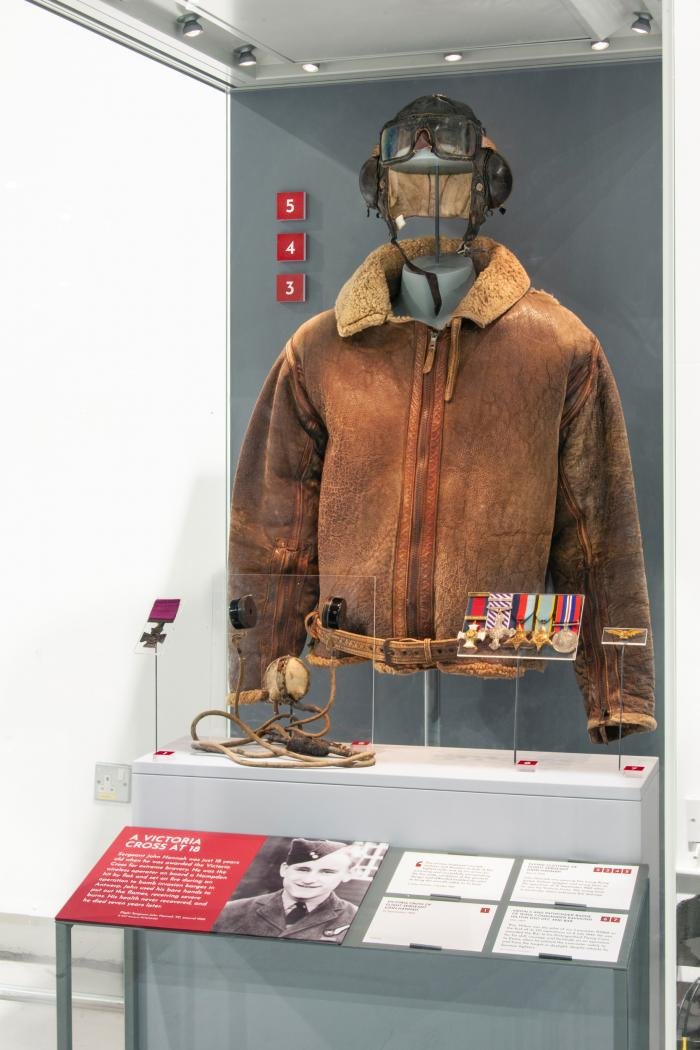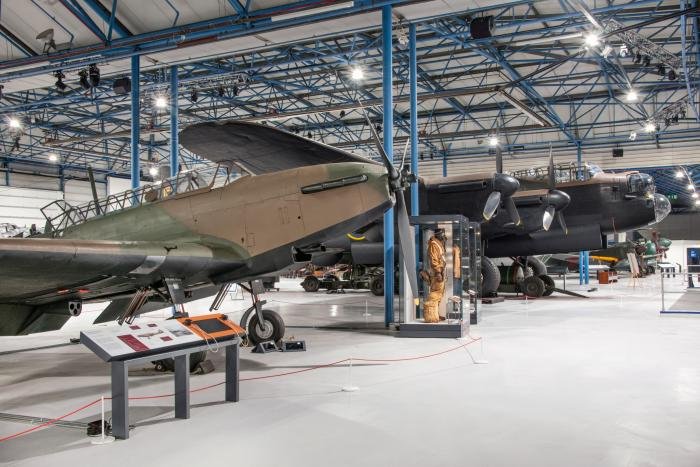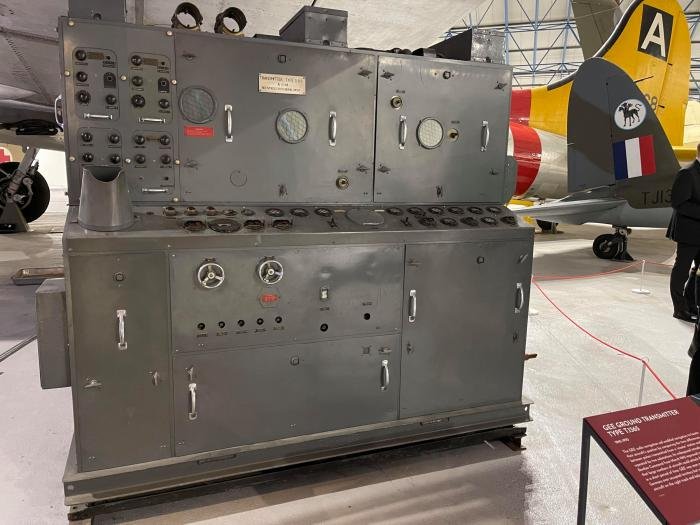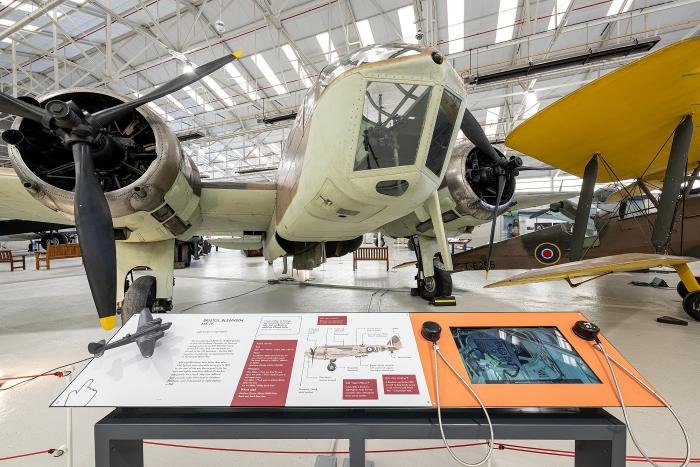Updated displays at Hendon and Cosford inaugurated on Ruhr dams raid anniversary — Aeroplane’s Tony Harmsworth was there

Two new Bomber Command exhibitions were unveiled at the RAF Museum’s London and Midlands sites on 16 May, the 80th anniversary of No 617 Squadron’s raid on the Ruhr dams. With the exception of Vickers Wellington X MF628, restoration of which has recently been completed at Cosford, there are no new aircraft on show, but a wealth of supporting exhibits have been brought out of storage to tell Bomber Command’s and the US 8th Air Force’s wartime stories in a far more personal, accessible style than previously.
Throughout the Hendon exhibition, silhouettes depict the stories of individuals who played crucial roles, like that of inventor Sir Barnes Wallis, Wg Cdr Raymond Hilton, the first operational captain of Avro Lancaster R5868, which is on display at the museum, and WAAF Cpl Lilian Bader, one of the first black women to join the British armed forces. The rear fuselage and vertical tail of Short Stirling III LK488 — recovered from Mickle Fell in the Pennines during 1977 and the largest section of the RAF’s first four-engined bomber to survive — is also now on show at Hendon, with another section of its fuselage exhibited at Cosford.

New showcases display personal objects taken from storage, such as the fire-damaged flying helmet, jacket and goggles belonging to wireless operator/air gunner Sgt John Hannah VC. On 15 September 1940, following a successful attack on German barges in the port of Antwerp, 18-year-old Hannah’s No 83 Squadron Handley Page Hampden, P1355, was hit by flak. With fire in the fuselage spreading rapidly, the navigator and rear gunner bailed out, but Hannah stayed aboard. Using two extinguishers and then his hands he managed to put the fire out, suffering severe burns in the process. The Hampden’s Canadian pilot Fg Off Clare Connor managed to fly the seriously damaged bomber back to base at Scampton, and immediately recommended Hannah for a VC. Hannah was the youngest recipient of the VC for aerial operations during the Second World War, but was never to fully recover from his injuries, passing away at the age of 25 in June 1947.
Regarding the process behind selection of exhibits, Ewan Cameron, curator of aircraft and exhibits at the RAF Museum store at Stafford explains, “It really starts with detailed research — most notably, some of the set texts that you really have to have read if you’re exploring this subject. These include the four volumes of Webster and Frankland’s official history of Bomber Command, Strategic Air Offensive Against Germany 1939-1945 and Arthur Harris’s report, Dispatch on War Operations. I also found the monographs published by the Air Historical Branch very useful when it came to technical pieces of kit.
“I was unusually lucky in a strange sort of way in that this research period coincided with the first lockdown during the pandemic. While many people were left twiddling their thumbs, I had a job to get on with, which was to read. This research then informed my choice of objects and topics to explore.
“As a curator of aircraft and exhibits — three-dimensional objects, basically — when it came to technical bits of kit, I already had a good idea of what I wanted to use. The thing that took a bit of time to research was the personal stories and the material we had in our archives. I think here I should emphasise that we can only show the items we have and that fact dictates the objects or stories we can tell. For instance, there is no person more worthy of inclusion in this exhibition than Leonard Cheshire VC, but when you have no three-dimensional or archival material relating directly to him and you do have that sort of material relating to Guy Gibson or ‘Micky’ Martin, then you are going to go with the latter two instead.
“We also have some animations covering topics like radio navigational aids, target-marking and ordnance. I think this is the part of this exhibition I’m proudest of. It was a lot of work but it’s the one thing I’ve had the most positive feedback about. It did help that working with the animators, a company called Spaceducks, was a complete pleasure as they were very enthusiastic about the exhibition, and I think that really shines through in what they produced.”

Regarding his favourite exhibits, Ewan continues, “Strangely, they are not the type of objects I would have thought would have been my favourites. I’m a great fan of black boxes or pieces of kit that turn a flying machine into a fighting machine. Take the airframe of a Lancaster, for instance. A Lancaster entering service in 1942 isn’t that different to one entering service in 1945. True, there are a few differences — the engines are a bit more powerful — but it’s still basically the same flying machine. It’s the equipment that gets fitted to the aircraft that changes its ability to carry out its job.
“The one item I was particularly keen on including were the telegrams sent to the next of kin of aircrew who had failed to return from operations. There’s something very powerful about the fact that these simple pieces of paper could herald the worst moment in that person’s life. Of course, these telegrams tend to inform the person that their son or husband was missing, but I’m fairly sure that most of the people who received them knew the significance and were bracing themselves for the worst news that would probably — and in the cases we have selected, inevitably — follow.
“The item I’m most happy to finally get on show is the canopy rail from a North American Mustang. It came from a P-51D, 44-15094, and was the mount of Howard E. ‘Pete’ Wiggins who flew with the 361st Fighter Squadron of the 356th Fighter Group at Martlesham Heath from May 1944 to January 1945. During that time, he undertook 75 combat missions, during which he gained four-and-a-half confirmed aerial victories and one-and-a-half enemy aircraft destroyed on the ground.

“What’s this got to do with Bomber Command? Well, I would say — and Webster and Frankland’s official history will back me up here — that you shouldn’t tell the story of the strategic air offensive against Germany without including the massive contribution of the US Army Air Forces. Their presence had a major effect on Bomber Command’s operations, and while the USAAF and RAF bombing campaigns may not have been as co-ordinated as was sometimes suggested, there is no denying the combined effect it had on Germany.”
Among the new exhibits to go on show at RAF Museum Midlands at Cosford are Wg Cdr Guy Gibson’s Victoria Cross and medal bar, a collection of aircraft nose art, and Bristol Bolingbroke (Canadian-built Blenheim IV) ‘L8756’, which has moved north-west having previously been on show at Hendon.


